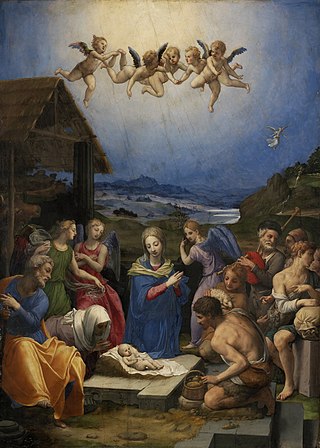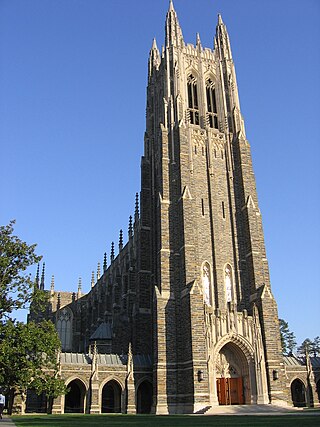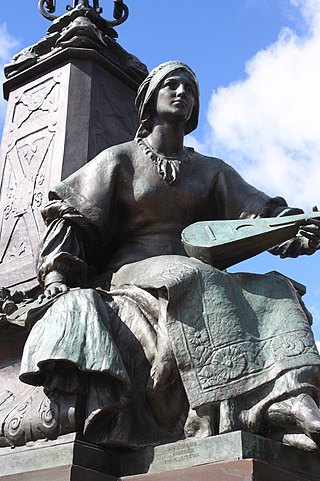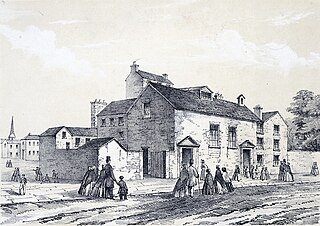
John Wesley was an English cleric, theologian, and evangelist who was a leader of a revival movement within the Church of England known as Methodism. The societies he founded became the dominant form of the independent Methodist movement that continues to this day.

Sir Joseph Edgar Boehm, 1st Baronet, was an Austrian-born British medallist and sculptor, best known for the "Jubilee head" of Queen Victoria on coinage, and the statue of the Duke of Wellington at Hyde Park Corner. During his career Boehm maintained a large studio in London and produced a significant volume of public works and private commissions. A speciality of Boehm's was the portrait bust; there are many examples of these in the National Portrait Gallery. He was often commissioned by the Royal Family and members of the aristocracy to make sculptures for their parks and gardens. His works were many, and he exhibited 123 of them at the Royal Academy from 1862 to his death in 1890.

"Hark! The Herald Angels Sing" is an English Christmas carol that first appeared in 1739 in the collection Hymns and Sacred Poems. The carol, based on Luke 2:14, tells of an angelic chorus singing praises to God. As it is known in the modern era, it features lyrical contributions from Charles Wesley and George Whitefield, two of the founding ministers of Methodism, with music adapted from "Vaterland, in deinen Gauen" of Felix Mendelssohn's cantata Festgesang.

Kingswood School is a private day and boarding school in Bath, Somerset, England. The school is coeducational and educates over 1,000 pupils aged 9 months to 18 years. It was founded by John Wesley, the founder of Methodism, in 1748, and is the world's oldest Methodist educational institution. The school was established to provide an education for the sons of colliers and Methodist ministers. It owns the Kingswood Preparatory School, the Upper and Middle Playing Fields and a number of other buildings.

Wesley Church is a Uniting Church in the centre of Melbourne, in the State of Victoria, Australia.

Duke University Chapel is a chapel located at the center of the campus of Duke University in Durham, North Carolina, United States. It is an ecumenical Christian or all-faith chapel and the center of religion at Duke, and has connections to the United Methodist Church. Finished in 1935, the chapel seats about 1,800 people and stands 210 feet tall, making it one of the tallest buildings in Durham County. It is built in the Collegiate Gothic style, characterized by its large stones, pointed arches, and ribbed vaults. It has a 50-bell carillon and three pipe organs, one with 5,033 pipes and another with 6,900 pipes.

Sir Edgar Bertram Mackennal, usually known as Bertram Mackennal, was an Australian sculptor and medallist, most famous for designing the coinage and stamps bearing the likeness of George V. He signed his work "BM".

Wesley's Chapel is a Methodist church situated in the St Luke's area in the south of the London Borough of Islington. Opened in 1778, it was built under the direction of John Wesley, the founder of the Methodist movement. The site is a place of worship and visitor attraction, incorporating the Museum of Methodism in its crypt and John Wesley's House next to the chapel. The chapel has been called "The Mother Church of World Methodism".

The West Street Chapel is a former chapel at 24 West Street, London WC2. It was John Wesley’s first Methodist chapel in London's West End.

Paul Raphael Montford was an English-born sculptor, also active in Australia; winner of the gold medal of the Royal Society of British Sculptors in 1934.

John Wesley's New Room is a historic building located between between The Horsefair and Broadmead, Bristol, England. Opened in June 1739, it housed the earliest Methodist societies, and was enlarged in 1748. As the oldest purpose-built Methodist preaching house (chapel), it has been designated by Historic England as a Grade I listed building.

Frederick William Pomeroy was a prolific British sculptor of architectural and monumental works. He became a leading sculptor in the New Sculpture movement, a group distinguished by a stylistic turn towards naturalism and for their works of architectural sculpture. Pomeroy had several significant public works in London and elsewhere in the United Kingdom, notably in Belfast. His work in London includes the figure of Lady Justice (1905–1906) on the dome of the Old Bailey.
The Wesleyan Methodist Church was the majority Methodist movement in England following its split from the Church of England after the death of John Wesley and the appearance of parallel Methodist movements.

Frederick Brook Hitch (1897–1957) was a British sculptor, the son of the architectural sculptor Nathaniel Hitch. He attended the Royal Academy Schools and was a Fellow of the Royal Society of British Sculptors. He lived in Hertford, Hertfordshire, England.
The Masbrough Independent Chapel was an Independent or Congregationalist chapel in the Masbrough district of Rotherham, from the 18th century until the 1970s, at which point it became part of the United Reformed Church.

The statue of John Wesley, St Paul's Churchyard is an outdoor bronze sculpture depicting the theologian, cleric and co-founder of the religious movement known as Methodism, John Wesley. The statue is located northwest corner of St Paul's Churchyard, London, England, and was erected in 1988. It was cast from a sculpture created by Samuel Manning and his son between 1825 and 1849.

St John's Church is in Emesgate Lane, Silverdale, Lancashire, England. It is an active Anglican parish church in the deanery of Tunstall, the archdeaconry of Lancaster, and the diocese of Blackburn. The church is recorded in the National Heritage List for England as a designated Grade II* listed building. It is notable for the high quality of the stone carving in the interior.

The Foundery, in Moorfields, was the first London foundry for casting brass cannon for the British Board of Ordnance. The building subsequently served as the first Wesleyan Methodist house of worship, and an important meeting place for the early Methodist community. In 1778, the Methodist congregation was moved to the nearby purpose-built Wesley's Chapel on City Road.

Clayton Wesley Uniting Church, formerly Clayton Congregational Church, is a Uniting church, located at 280 Portrush Road, Beulah Park, Adelaide, South Australia, Australia. The current building with its tall spire was built was built in 1883, although an earlier building, behind the present church and now known as the Lecture Hall, was built in 1856. The church is located in a commanding position at the eastern end of The Parade, Norwood.
Elijah Hoole was an English architect of Methodist churches, settlement halls and social housing. In relation to the social housing, he worked closely with the social reformer Octavia Hill for over 40 years.


















